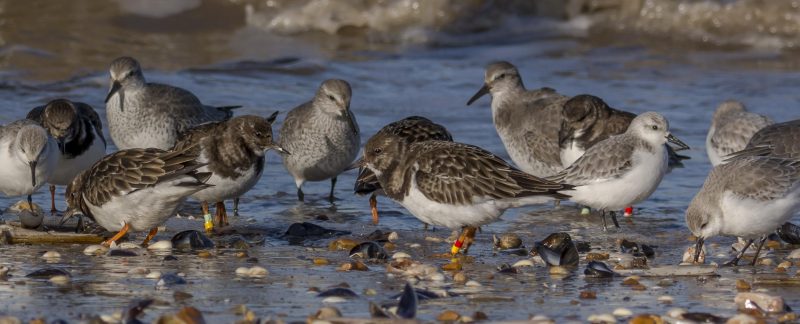Regular attendees to The Wash (and everyone we encounter) may wonder why we typically devote one out of three tides of fieldwork to resighting colour-marked birds (as well as having some ‘resighting only’ weekends). Using colour marks alongside metal rings allows us to study aspects of wader ecology which cannot be investigated using metal rings alone. We now colour mark a variety of species and further information on our colour-marking schemes can be found here.
So what are the extra things we can study? We can discover the survival rate of our marked populations (either year-on-year or seasonally e.g. over winter). There is a range of established statistical techniques to estimate survival. However, they require regular re-encounters from a minimum sample of 50 marked individuals to work, and ideally more if we are to get estimates that are sufficiently precise to detect differences, either over time or between sites. Unfortunately, we don’t get that much data from metal ringing alone – the chances of re-trapping any particular individual are just too low. Hence for our Curlew and Bar-tailed Godwit projects, we aim for over 100 individuals to be resighted each year. Since 2016, we have achieved this goal for Curlew and Bar-tailed Godwit. This extra sample of colour-marked Curlew has already proven its worth by being included, along with the longer-term metal ring data, in a nationwide study of UK Winter Curlew survival to better understand the conservation priorities for this species. Our new Redshank project is now also close to providing annual survival estimates for this declining species.
Colour-marking also helps us to understand how subgroups of birds use different areas of The Wash over winter. Our work on Curlew and Bar-tailed Godwit has shown that more male than female birds use The Wash over winter (with more females wintering elsewhere), and male Curlew frequently feed in surrounding fields (known as ‘functionally linked land’ – this is land next to a protected area which birds use). We are now investigating habitat use further, using tags that automatically download data to the mobile phone network, on a smaller subset of individuals.
Movements of individual waders can be appreciated in more subtle detail than from metal ring recoveries alone. Our current Knot project has a key aim of investigating post moult movement of Knot from The Wash to other sites in the North Atlantic. To date we have had sightings of WWRG-marked Knot from various locations in the UK including Scotland, Merseyside, Lancashire, Humberside and Dorset as well as from several countries including Spain, Ireland, The Netherlands and Iceland. Black-tailed Godwit caught by the group often have multiple resighting locations that identify the breeding, wintering and passage sites used by individuals – see here. The use of food resources around The Wash can also be investigated from observations of colour-ringed birds. Our colour-marking studies with Turnstone were started to study the effect of artificial food sources (in this instance, spilt grain at Port Sutton Bridge) – see here.
By marking juvenile birds, we can discover not only how many birds survive their first winter and enter the adult breeding population (often referred to as ‘recruitment’) but also where these individuals spend their first summer as non-breeding birds. This works because, unlike metal rings, colour marks (rings or flags) can be spotted without the need to catch the birds. Our recent Knot project will hopefully provide new insights into this aspect of population studies. In 2021, we had several second calendar year birds spending the summer on the Lincolnshire side of The Wash whilst, in 2022, we had over twenty individual birds reported from the Dutch Waddensea.
We have now recorded over 10,000 sightings of colour-marked birds. One recent improvement to aid fieldwork is an easy way to record sightings through a web-based form developed by group member Stephen Vickers and currently being trialled by group members. This allows anyone who has seen a colour-marked bird to input their data and immediately provides a history of previous encounter(s) of those birds, with a location map. This will hopefully allow both WWRG members and others who see ‘our’ birds to become more engaged with this important aspect of our fieldwork.
So there you have it: the benefits of WWRG resighting fieldwork explained (and the real reason why some group members have a seemingly unhealthy obsession with coloured plastic!). Recording colour marks is now an essential component of our work: a wide pool of contributors ensures long-term project sustainability. Our Turnstone project has been running for over 20 years (older than some of our younger participants), and our Bar-tailed Godwit/Curlew project is now old enough to go to secondary school. The WWRG ringing dataset is unique globally in terms of its scope and longevity: re-sightings of colour-marked birds will be an increasingly essential component in our continuing efforts to monitor the health of the wader populations using The Wash.
Blog written by Rob Pell

